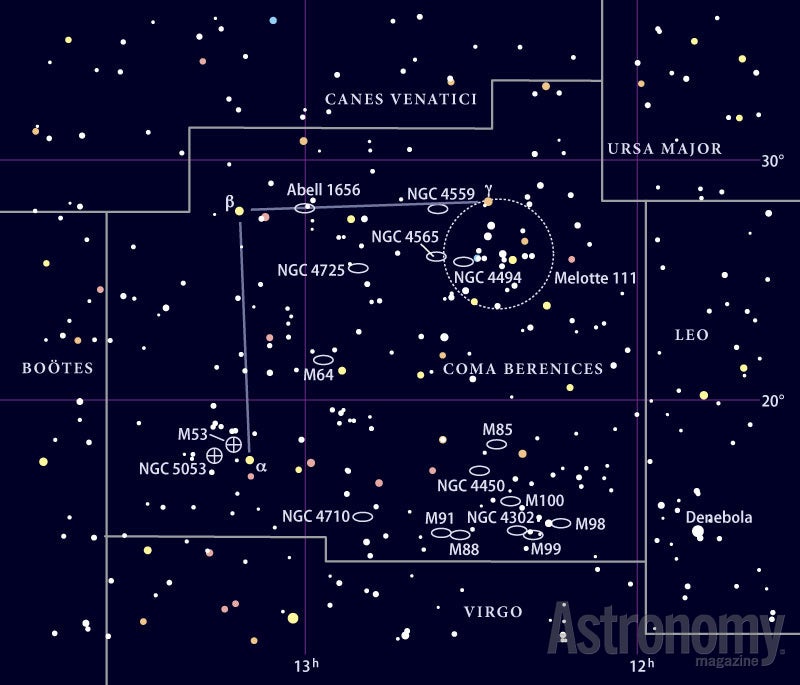Targets for June 16–23, 2016
Naked eyes: The Coalsack
Small telescope: The Blackeye Galaxy (M64)
Large telescope: Planetary nebula IC 972
This week’s naked-eye object lies in the southern constellation Crux the Southern Cross. Although Crux is the smallest of the 88 constellations, it’s also the brightest when measured by stars per unit area. Any dark object, therefore — especially one as large as the Coalsack — will stand out.
Astronomers classify the Coalsack as a dark nebula, an object made of dust and cold gas. The Coalsack falls mainly within the boundaries of Crux, but parts of it lie in the adjoining constellations Musca and Centaurus. To observe the Coalsack, you must be at a location south of about latitude 25° north, and even from there the Coalsack will hug the southern horizon. The Coalsack covers a whopping area 6.7° by 5°.
It has the greatest impact as a naked-eye object. The inky black void contrasts strongly with the Milky Way. When you use optical aid, the field of view shrinks, and that lessens the contrast with the surrounding rich star field. Also, binoculars and telescopes reveal the Coalsack is not devoid of stars, taking away from its appeal somewhat.
Through the years, observers have called the Coalsack by a variety of names. Two of the most popular are Magellan’s Spot and the Black Magellanic Cloud. And although we can’t give a discovery date — Southern Hemisphere residents had seen it for thousands of years — Spanish explorer Vincente Yánez Pinzón reported observing it in 1499.
The black eye in the sky
This week’s small-telescope target is the Blackeye Galaxy in Coma Berenices. This galaxy also carries the designations M64 and NGC 4826.
English astronomer Edward Pigott discovered M64 March 23, 1779. Messier independently found it a year later and added it to his catalog. William Herschel discovered this spiral galaxy’s dark dust feature, which he compared to a black eye. The name caught on.
You’ll find this object 5.2° northwest of magnitude 4.3 Alpha (α) Comae Berenices. Through a 4-inch telescope under a dark sky, you’ll see the dark region that gave this galaxy its common name. You also will identify M64’s overall oval structure and its much brighter central region. It measures 9.2′ by 4.6′, and it shines at magnitude 8.5, a light output that makes it one of the sky’s brightest galaxies.
The dust lane becomes prominent when viewed through an 11-inch or larger scope. The lane sits north of the nucleus, separating the galaxy’s core from the northern spiral arm. The arms wrap tightly around the core, so you’ll need a 16-inch scope to see any detail in them. If you view M64 through a scope of this aperture, look for the halo formed by the arms’ outermost regions.
A non-galaxy in Virgo
This week’s large-telescope target is planetary nebula IC 972 in Virgo. Although most deep-sky targets in that constellation are galaxies, this planetary is certainly worth a look. This faint target, also known as Abell 37, glows weakly at magnitude 13.9 and measures 43″ across. To find it, look 5.2° southwest of magnitude 4.5 Lambda (λ) Virginis.
At nearly 14th magnitude, some amateur astronomers might pass IC 972 by for less difficult targets. That’s fine if you’re viewing through a 4-inch scope, but if you have an 11-inch or larger instrument and a dark observing site, have a look at the shell of gas that once made up the faint outer layers of this Sun-like star.
Because of its small size, IC 972 has a reasonable surface brightness, and that’s why you can see it through a large amateur telescope. It appears uniformly illuminated with a sharp edge. An Oxygen-III (OIII) filter will help with this observation.
Observers have glimpsed the central star, but not easily. At magnitude 17.9, you’ll need a 24-inch or larger scope to attempt sighting this dim bulb. Oh, and be sure to remove the OIII filter before trying to spot the central star.
By the way, the “Abell 37” designation comes from a catalog compiled by American astronomer George Abell. He searched through images taken as part of the Palomar Observatory Sky Survey, which occurred in the 1950s. Abell identified 80-some objects that looked like previously unidentified planetary nebulae. IC 972 was number 37 on his list.
Expand your observing at Astronomy.com
The Sky this Week
Get a daily digest of celestial events coming soon to a sky near you.
Observing Basics
Find more guidance from Senior Editor Michael E. Bakich with his Observing Basics video series.










